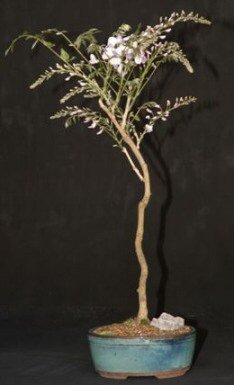Recall that acid soils contain a pH measurement below the normal 6.5-7.5 range. Depending on which area of the country you live in, the chances are good that at least a portion of your planned garden may contain acidic soils.
Of course, there are many more, but that will serve to give you an example of some. Also remember that acid soils tend to retain moisture, so you may need to work in a good amount of organic matter to assist drainage.
If you have determined that your soil is highly alkaline, and you really want to plant those azaleas or those rhododendrons, about the only way you're going to get successful results in your garden area is if you make them a special bed, called a raised bed. Typically, this structure is created from any number of woods, such as posts, railroad ties or stacked 2x4's. People also make raised beds out of brick and slump stones, but to keep costs down, wood is your best bet.
Gardening in raised beds has been practiced in the United States since the colonial days. It made a big comeback during the 60's, and then faded again, though the 21st century has seen a growing resurgence of popularity among home vegetable growers. In parts of the world with greater population densities or less tillable land, yard gardening is still heavily practiced.
"Raised" means that the soil level in the bed is higher than surrounding soil, and "bed" implies a size small enough to work without actually stepping onto the area used. A raised bed should be no more than 4 feet wide, while length can be whatever suits the site or individual gardener's needs. Wider beds can be subdivided into sections accessible from pavers, stepping-stones or planks if desired.
There are several different reasons for creating a raised bed, many of them practical, others more aesthetic in nature. Some of the most common reasons are:
Higher Yields: A raised bed provides more production per square foot of garden. In a traditional home garden, good management may yield about 0.6 pounds of vegetables per square foot while a raised bed may double that amount. In addition, raised beds do not require the usual space between rows, because no walking is done in the bed to cultivate or harvest.
Improved Soil Conditions: Typically, soil compaction reduces many crop yields by up to 50 percent. Water, air and roots all have difficulty moving through soil compressed by tractors, tillers or human feet, but gardeners can avoid the problem by creating beds narrow enough to work from the sides. Soil organic matter content can be increased greatly without getting bogged down.
Raised beds also help in problem soil situations where gardeners must deal with low spots unsuited for conventional gardens because of erosion from runoff. Raised beds, using frames as a foundation, avoid this issue and soil acidity can be maintained in the 5.8 to 6.8-pH range, which is preferable for most vegetables.
Easier Working Conditions: The most important benefit of gardening with raised beds is the increased ease of planting and harvesting. Many people avoid working traditional gardens in rainy weather to avoid compaction and muddy feet. Because raised beds are designed to avoid trampling, gardeners avoid muddy feet. Spaces between beds may be mulched or even paved with stone or brick.
Better Pest Control: Pest control also becomes less difficult in raised beds. If burrowing rodents are abundant, the bottom of the bed can be lined with poultry wire or hardware cloth. Placing favorite foods in a framed bed with a low fence can deter rabbits and groundhogs from raiding your vegetable garden. The narrow dimensions of raised beds make it easier to spread bird netting suspended on frames to keep them from pecking at leaves and vegetables, and weed control with plastic sheeting is much easier, as the width of the bed can be spanned by one roll.
Water Conservation: The narrow dimensions of beds make them ideal for water conservation. Canvas soaker hoses and drip-type irrigation hoses direct water to the soil where it is needed most and reduce disease problems which occur from watering with overhead sprayers or sprinklers.
Acid Loving Plants: It may be that your soil is acidic and you find yourself having to adapt to the plants and shrubs you have chosen for your garden to suit acid-loving plants, or you may also find that your soil is nearly perfectly balanced in pH levels and that you don't have acidic soils. You can choose some common plants that prefer acidic soil, such as:
1) Rock rose
2) Azalea
3) Rhododendron
4) Witch Hazel
5) Camellia
6) Bearberry
7) Dogwood
8) Trumpet Vine
9) Wisteria
"Raised" means that the soil level in the bed is higher than surrounding soil, and "bed" implies a size small enough to work without actually stepping onto the area used. Typically, this structure is created from any number of woods, such as posts, railroad ties or stacked 2x4's. People also make raised beds out of brick and slump stones, but to keep costs down, wood is your best bet. There are several different reasons for creating a raised bed, many of them practical, others more aesthetic in nature.
Copyright © Larry Gildea, All Rights Reserved.











